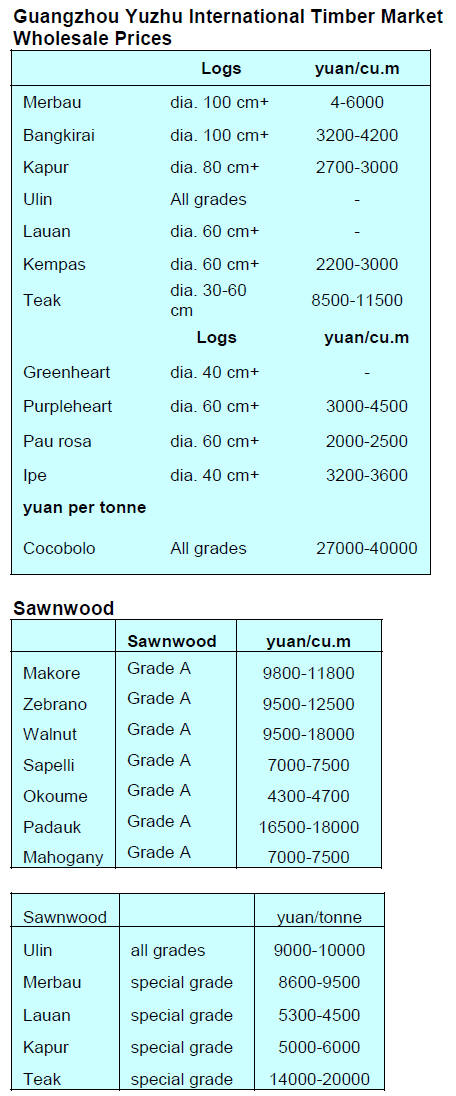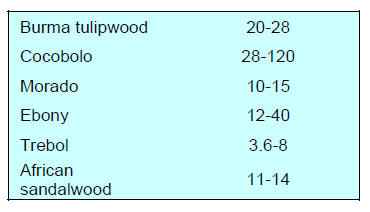US Dollar Exchange Rates of 10th
March 2017
China Yuan 6.9071
Report from China
Snapshot - 2016
Dependence on wood product imports rising
In spite of being one of the biggest wood product
producers in the world the output from China¡¯s wood
products sector is insufficient to satisfy domestic demand.
China¡¯s dependence on the imports of wood products
continues to grow and this trend is unlikely to slow
especially as now a total ban on commercial logging in
national forests is in effect.
Economy and housing
Achieving growth was tough for Chinese policy makers
throughout 2016. Even with loosened liquidity and
government intervention, annual growth fell to a
consistent 6.7% in the first three quarters of 2016, the
slowest rate seen in 25 years.
However, these numbers disguise some weaknesses in the
economy. The main concern is that fixed asset investment
is no longer coming from the private sector.
Manufacturing overcapacity in many sectors is a burden
and while the services sector did exceptionally well in
2016 the pace of expansion is unlikely to be sufficient to
compensate for downturns elsewhere.
With the accelerating incomes and rapid urbanisation,
enthusiasm for owning a home continues to drive the
housing market. China¡¯s National Bureau of Statistics has
released 2016 data on real estate investment during the
year showing total investment in the sector was up 6.9%
year on year of which investment in residential buildings
was up by 6.4% and accounted for 67% of all real estate
investment. However, in 2016 the area purchased by the
real estate developers fell 3.4% as they anticipated tougher
times ahead.
The real estate market, which was especially active in
early 2016, delivered an enormous market for wood and
wood product imports before the brakes were applied to
the overheated market. For example, in the first 7 month
of 2016, imports of sawn timber grew 17% year on year,
log imports rose 3%; plywood imports jumped almost
20% and MDF imports rose 16%.
But the reason for rising imports of wood products is not
only demand in the housing market. In recent years many
Chinese enterprises have been importing high quality
wood-based boards in order to meet mandatory standards
for formaldehyde emission for panel style furniture or
wood flooring manufactured for international markets.
For example, according to China Customs, in the first nine
months of 2016 particleboard imports rose a staggering
32% to 560,200 cubic metres mainly from Malaysia,
Thailand, Romania, Germany and Brazil.
Appetite for logs continues but not tropical logs
The firm appetite of Chinese companies for imported logs
continued into 2016. Total log imports topped 19 million
cubic metres (17% up year on year) but what was startling
was the decline in tropical log imports.
In 2015 tropical log imports accounted for around 40% of
all log imports but this tumbled in 2016 to just 18%. 2016
imports of tropical logs amounted to just 9.3 million cubic
metres from the 19 million imported in 2015.
In contrast to the trend in tropical log imports, China¡¯s
2016 tropical sawnwood imports continued an upward
trend that had been observed over the past few years. Of
the 32 million cubic metres of sawnwood imported in
2016, some 20% was from tropical suppliers and the
proportion of tropical to total sawnwood imports (18%)
was maintained into 2016.
African blackwood shipments closely scrutinised
The authorities at Zhangjiagang Port have cracked down
on importers bringing in African blackwood (Dalbergia
melanoxylon). If the appropriate CITES documents cannot
be provided shipments will be seized. China imports
African blackwood from Mozambique.
Russians check timber destined for China
Information released by the Khabarovsk Customs in
Russia¡¯s Far East says as of 1 March, timber exported to
China are being carefully monitored to ensure shipments
are in accordance with the latest export restrictions.
In January this year Russian Prime Minister, Dmity
Medvedev, signed into law an ordinance that placed
further restrictions on log exports. The export of Russian
birch logs with a diameter of less than 24 cm and less than
one metre in length is now banned. In addition, Russian
law enforcement agencies have stepped up efforts to crack
down on timber smuggling.
For more see:
http://www.wood365.cn/News/NewsInfo_246138.html
Shipment to US fails quarantine regulations because
of crating
According to Ningbo Entry-Exit Inspection and
Quarantine Bureau in Zhejiang Province, both the volume
and value of wood products exports by manufacturers
based in Ningbo City increased in 2016 and the value of
wood product exports topped US$410 million.
Markets such as the USA, Japan, France and the UK
accounted for the bulk of exports but, overall, shipments
were made to 140 different countries.
According to the Ningbo Entry-Exit Inspection and
Quarantine Bureau, a shipment of pianos from the City
was rejected by the US Customs because the pianos were
crated in timber that not been treated. This resulted in the
exporters sustaining huge losses.
The Ningbo Bureau is paying now more attention to all
aspects of shipments. Joint efforts between the city¡¯s
government departments, industry associations and
enterprises are underway.
The local authorities have assumed responsibility to
inform enterprises of the latest trade regulations and are
arranging training. The timber associations have
formulated a code of conduct covering wood products
processing and shipments with emphasis on wooden
packaging.
Recovery in radiata log exports to China
Log exports from New Zealand to China have recovered
strongly following improved demand over the past year.
China is New Zealand's largest market for logs and
sawnwood. The recovery in exports from New Zealand
follows a slump caused by excessive inventory in 2015.
Improved demand for radiata logs in China was behind the
2016 success of Port of Tauranga in New Zealand.
Log exports via the Port increased over 20% in 2016 to
almost 3 million tonnes according to a reports in the New
Zealand Herald .
Tauranga is New Zealand's major log export port,
accounting for 30% of all log exports. In 2016 New
Zealand¡¯s log exports increased in the 2016 to around
NZ$2.5 billion with the Chinese market absorbing around
75% of this. South Korea and India were the other main
destinations.
See: http://www.nzherald.co.nz/bay-of-plentytimes/
news/article.cfm?c_id=1503343&objectid=11806907

 
|